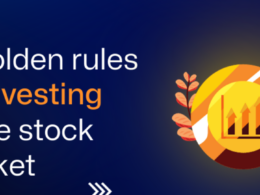Table of Contents
Discover the essentials of automating your investments.
We review all suggested products and services on our own. We might earn a commission if you click on the links we share. Find out more.
Automated investing can make building wealth easier. When you automate your investing, money gets deducted from your paycheck and put directly into your 401(k) or investment account, making you less likely to miss it. Whether new to investing or an experienced trader, automated investing is an important strategy for growing your investments over time. This guide shows you how to automate investing, from reinvesting dividends to setting up regular transfers with a robo-advisor.
How to Automate Your Investing
Automating your investing is usually fast and simple. Before you start, check the platform’s FAQ section to see the account minimums and any required approvals. Each platform has its own way of doing things. Then, gather your bank details and personal info, such as your Social Security number. The investment platform will guide you through the setup step by step.
Here’s what to expect when you’re creating your automated investing account:
1. Create an investment account: Setting up your account includes picking a user ID and password. Next, you’ll choose the type of account you want, like a regular investment or retirement account. If you’re an experienced trader who wants to use leverage in swing trading, you might need approval for certain brokerage accounts.
2. Choose your assets: When using robo-advisors or micro-investing apps, you’ll answer some questions about your goals, how much risk you’re okay with, and how long you plan to invest. Then, the platform will pick investments for you. Workplace retirement accounts list investments, while self-directed accounts offer many stocks, bonds, ETFs, and mutual funds. You can often find helpful articles on the website to guide you in choosing your investments.
3. Link your funding account: To transfer funds, you pick your checking or savings account. You’ll need the name of your bank, its routing number, and account number. This step isn’t needed for a 401(k), 403(b), or 457 account because money gets automatically taken from your paycheck and put into your retirement account.
4. Set your funding schedule: With robo-advisors, round-up apps, and self-directed accounts, you choose how often and how much money you want to move from your bank to your investment account. Make sure to set up a transfer big enough with your workplace retirement account to get the employer match. Also, know the most you can put into your 401(k).
Best Automated Investing Platforms
| Platform | Best For | Account Minimum | Fees |
| Wealthfront | Best Overall, Best for Portfolio Management, Portfolio Contents, & Best for Goal Planning | $500 for investment accounts, $1 for cash accounts, $0 for financial planning | 0.25% for most accounts, no trading commission or fees for withdrawals, minimums, or transfers. 0.42%–0.46% for 529 plans |
| Betterment | Best for Beginners & Cash Management | $0%10 to start investing | 0.25% (annual) for investing plan or a $4/month fee for balances under 20K, 0.40% (annual) for the premium plan |
| M1 Finance | Best for Low Costs, Socially Responsible Investing, & Sophisticated Investors | $100 ($500 minimum for retirement accounts) | $0 |
| E*TRADE Core Portfolios | Best for Mobile | $500 | 0.30% |
| Merrill Guided Investing | Best For Education | $1000 or $20,000 with an advisor | 0.45% annually of assets under management, assessed monthly. With advisor—0.85%. Discounts are available for Bank of America Preferred Rewards participants. |
Understand the Top Automated Investment Types
There are different ways to set up an automatic investment plan. We’ll explain options from robo-advisors to your employer’s 401(k). Pick one or more automated investment methods to start turning today’s earnings into wealth for the future.
- Robo-advisors like Wealthfront, Betterment, Fidelity Go, and Schwab Intelligent Portfolios offer a low-cost way to invest wisely. You tell the robo-advisor your goals and how long you plan to invest, and it creates a portfolio that fits your needs. Set up automatic transfers into a regular or retirement account, and the robo-advisor manages your investments based on your wants. Some robo-advisors also provide access to human financial advisors and other services.
- Employer-sponsored retirement accounts. Many employers offer retirement savings options like 401(k), 403(b), or 457 accounts. You decide how much of your paycheck you want to put into the account. Some employers also match a portion of your contribution to a certain percentage. The money you put in is invested in stocks, bonds, or a mix of both, based on your choices. And while it’s in the account, your money grows without tax.
- Dividend reinvestment plans (DRIP): A DRIP is a feature in your investment account that automatically reinvests all your dividends and capital gains into the same asset. By reinvesting this income into more shares, your account value grows faster.
- Recurring transfer: You can instruct your bank to transfer a set amount of money from your checking or savings account to your investment account regularly. This transfer can be scheduled daily, weekly, monthly, or on any other regular basis. To avoid overdrawing, ensure you don’t withdraw more money than you have in your account.
- Rounding up: Apps like Acorns and other round-up micro saving and investing apps let you connect your debit or credit card to the app. Once connected, you can round up your purchases to the next dollar, up to ten times the original amount. The rounded-up amount is then automatically transferred into your investment account every time you use that card to make a purchase.
What You Need to Open an Automated Investing Account
First, discover what details you need to open an automated investing account.
Personal Information
The information and documents needed for the onboarding process usually include:
- Full Name
- Social Security Number or Taxpayer Identification Number
- Home Address
- Phone Number
- Email Address
- Driver’s License, Passport, or other Government ID Information
- Job Status and Occupation
- Whether you work for a brokerage firm
- Yearly Earnings
- Total Assets
- Investment Goals and Comfort with Risk
Minimum Deposits
Good news for investors: most automated investment accounts have low minimum deposit requirements. These can start from zero at many popular investment brokerage firms and go up to $100,000 at the Empower robo-advisor, which also offers access to certified financial planners.
If you’re new to investing and just starting, you can open an automated investing account at a big brokerage firm like E*TRADE, Fidelity, or Charles Schwab. They don’t need a minimum investment. Or, if you want a robo-advisor with low minimums, SoFi Automated Investing, M1 Finance, Betterment, Ally, and Ellevest all require less than $100 to start.
Factors to Consider When Opening an Automated Investing Account
When it comes to automating your investments, many options can make it hard to decide. To help you choose, consider these factors:
Customer service: Phone customer service is crucial for new and experienced investors. Some platforms don’t provide live customer service. If talking to someone is important, check if live customer service is available and when you can contact them.
Fees and commissions: Studies by Vanguard and other companies have found that lower fees often lead to better investment results. Before investing with any platform, ensure you know the fees you’ll be charged, like management fees and fund expense ratios. Decide if the services you’ll get are worth the fees.
Account minimum: Check how much money you need to start and keep the account. See if there’s a minimum balance required and if it fits your finances.
Research tools: Before opening a self-directed investment account, check the screeners, calculators, trading platforms, and research reports available. If you prefer managing your investments independently, ensure that the research tools provided meet your requirements.
1. What Is Automated Investing?
Ans: Automated investing is a way to make sure you save and invest regularly for the future. It helps us stick to our goals, especially when we forget them over time, like New Year’s resolutions.
This strategy is great for anyone who wants to turn today’s earnings into tomorrow’s wealth. It’s useful for saving for retirement, a child’s education, building wealth, or any goal more than five years away.
Setting up automated investing is simple. First, choose where you want the money, like your paycheck or bank account. Then, decide where to invest, like your work retirement account or a robo-advisor. You can also reinvest your earnings from stocks and investments. After that, pick the specific investments you want to invest in.
Finally, decide how much and how often you want to invest automatically. Once it’s set up, your money will go into your chosen accounts and investments without you needing to do anything. This helps you keep investing even when the market goes down, and you can benefit from the saying, “Buy low, sell high.”
2. How Does Automated Investing Work?
Ans: Automated investing is similar to setting up automatic bill payments. You decide how much money you want to invest, where you want to invest it, and how you’ll fund your investments. Once it’s all setup, money will be regularly transferred from your bank account or paycheck to your investment accounts. If you have a self-directed account, you might need to take an extra step to choose how to invest your money. But if your brokerage offers pre-built portfolios, you can skip this step. Alternatively, you can use a robo-advisor, which will automatically invest your contributions based on the rules you set up when you opened your account.
3. Is Automated Investing a Good Idea?
Ans: Automated investing is a smart choice for almost everyone. Studies in behavioral finance show that we don’t always make the best financial decisions. Automated investing can help overcome this by preventing irregular investing or avoiding investing altogether. It takes money out of your account before you can spend it and puts it into long-term assets, helping you build wealth over time.
4. Is Automated Investing Risky?
Ans: Investing in financial markets carries risks because the value of your investment can go down. Interestingly, automated investing might be seen as less risky than doing it yourself. You’re using a dollar-cost averaging strategy by consistently putting money into the markets, whether up or down. This means you’ll buy more shares when prices are low and fewer when prices are high, following the advice to “buy low.”
5. Are Micro-Investing Apps a Good Choice?
Ans: Micro-investing apps have advantages and disadvantages. The good thing about these round-up apps is that you can start investing and keep doing it regularly. However, the downside is that if you only invest your spare change and don’t set up bigger automatic deposits, it’ll take a while to build up a significant amount in your account.
Let’s say you put $50 of spare change into your investment account every month, earning an average of 7% annually. After ten years, your account would be worth about $8,704. Now, if you add a $350 monthly auto-deposit on top of the $50 spare change investment, you’d be investing $400 monthly. With the same 7% annual return, your account would grow to roughly $69,637 in 10 years.
6. Should I Use an Automated Investing Platform?
Ans: There are many reasons to use an automated investing platform.
- Automated investing prevents you from not saving enough for the future.
- Automated investing saves you time.
- Robo-advisors offer great ready-made investment portfolios you can set up and leave alone.
- Dividend reinvestment handles what to do with capital gains and income payments.
Anyone looking ahead to the future should think about starting automated investment plans.










